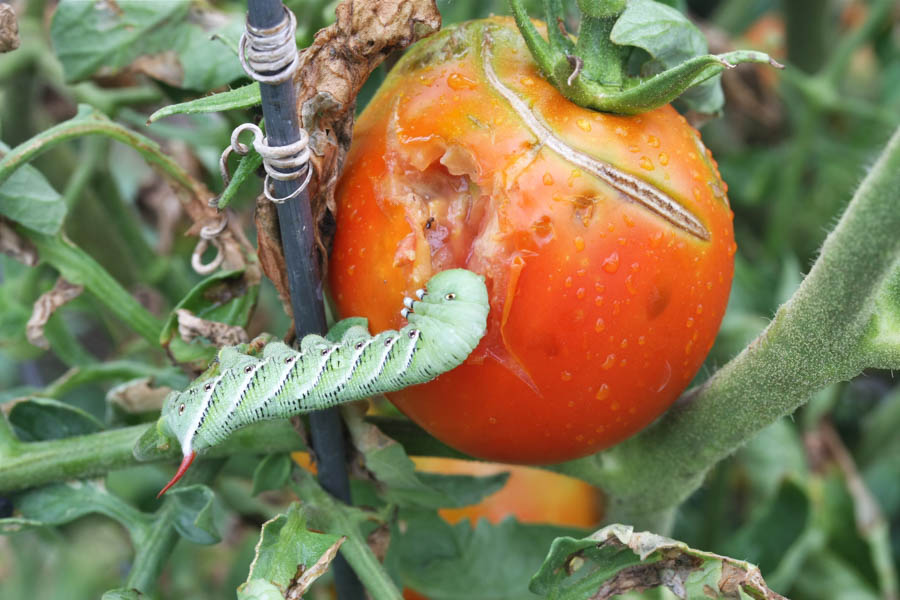Tomato and Tobacco Hornworms in the California Home Garden

See customized advice and information for growing tomatoes in your Southern California zipcode
Don’t know your GardenZeus California Climate Zone? Enter your zipcode at GardenZeus.com.
GardenZeus receives commissions for purchases through links in this post.
As a longtime gardener with an ever-untamed inner child, I still respond to hornworm infestations more like I would to finding a herd of destructive-but-nevertheless-adorable baby buffaloes grazing in my garden. I don’t want my tomatoes or tomato plants to be destroyed any more than the next gardener, but I admit to finding hornworms and their adult moths to be exciting and beautiful. I’m more likely to emit excited laughter or a string of “wows” than to feel the annoyance or distress that I would with an infestation of aphids or spider mites. My first impulse with hornworms is to take pictures and invite friends or any children nearby to come see the massive bugs, while stopping the infestation may tend to come as an afterthought.
Like buffaloes should they ever cause an infestation, hornworms are most definitely out of place in a productive vegetable garden. Hornworms are much-despised in general by gardeners, as they cause truly massive damage to tomato leaves, blossoms, and fruits, about what you might expect from an infestation of starving tomato-loving buffaloes.
Tomato and tobacco hornworms are the mega-arthropods of the California home garden, the largest caterpillars or insects period that you’re ever likely to encounter in your garden or landscape. Far from being the tiny insect pests or even large caterpillars of many other species of moths or butterflies, hornworms are sized more in the range to make humans feel like we’re in the presence of admittedly small but still noteworthy beasts. They bring the surreal giant-insect feel of the tropical jungle to the California home garden. Tomato hornworms may reach 4 inches in length with thick soft bodies that look like they should provide an excellent meal for wildlife, and with plenty of leftovers.
Moth (pictured above) from a garden hornworm or closely related species
Adult hornworms are magnificently beautiful large moths, with a wingspan that can reach over 5 inches, larger than many hummingbirds, in mottled and exquisite patterns of grey and/or brown with white and tan, and with identifying orange spots in the case of both the Tobacco Hawk Moth and the Carolina Spinx Moth, the adult form of tobacco hornworms. Adult moths generally become active shortly after dusk or at earliest evening darkness, and at a glance may be confused with hummingbirds as they hover near flowers to feed on nectar. If you think you’re seeing a hummingbird feeding at night, look closely: it may be a sphinx or hawk moth.
Tobacco hornworms (pictured immediately above) can be identified by the red horns at their rear ends and 7 diagonal white stripes on each side of their bodies, while tomato hornworms have black or blue horns and 8 V-shaped stripes.
In California the worst hornworm infestations normally occur midsummer and late summer. In severe infestations, tomato plants rapidly become defoliated; plants may look like a frenzied gardener attacked them in an attempt to remove all leaves with pruning shears. Hornworms readily eat unripe and green tomatoes, leaving open wounds and white-scarred sections. Their feeding on ripe tomatoes can look like a human being took a bite from the fruit while it was still on the vine.
Hornworms also feed on the leaves and in some cases flowers and fruits of other plants in the Solanaceae family including eggplants, peppers, potatoes, and tobacco; as well as Ipomoea species such as moonflowers and Daturas such as jimsonweeds.
While hornworms may cause massive economic loss to commercial farmers, and while various effective biological and chemical controls are available, I have not yet seen a hornworm infestation in a small home garden that could not be controlled by manually removing the hornworms. If you have less than a quarter acre planted in tomatoes, I recommend going at it first to remove hornworms by hand. They are most active after dusk and early morning before dawn, just before full darkness and before morning light. The challenge with hand-picking is that despite their size, hornworm coloration can make them difficult to find. This is easily overcome by searching for them after dark using a black-light or ultraviolet flashlight.
There isn’t much to be found in the California home garden that is more exciting to outdoors-loving children than a hornworm. In my experience, upon seeing their first-ever hornworm, many children will ask: “Can I keep it as a pet?” and the answer is yes if you as a parent can stand the thought, and with proper care, but only for a short period, as hornworms typically stay in the larval stage as a caterpillar for only a few weeks before they pupate and turn into moths.
If you have kids, consider your hornworm infestation a special opportunity for a memorable-to-screamingly-exciting hornworm hunt as a nighttime sleepover activity using UV flashlights.
See customized advice and information for growing tomatoes in your Southern California zipcode
Yellow Leaves on Tomato Plants: A GardenZeus Guide, Part 1 of 3 (Management and Maintenance Issues)
Yellow Leaves on Tomato Plants: A GardenZeus Guide, Part 3 of 3 (Pests and Diseases)
GardenZeus Tips for Fertilizing Tomatoes During the Growing Season
The GardenZeus Guide to Staking, Supporting and Trellising Tomato Plants
GardenZeus Solutions to Common Abiotic Problems With Garden Tomatoes

